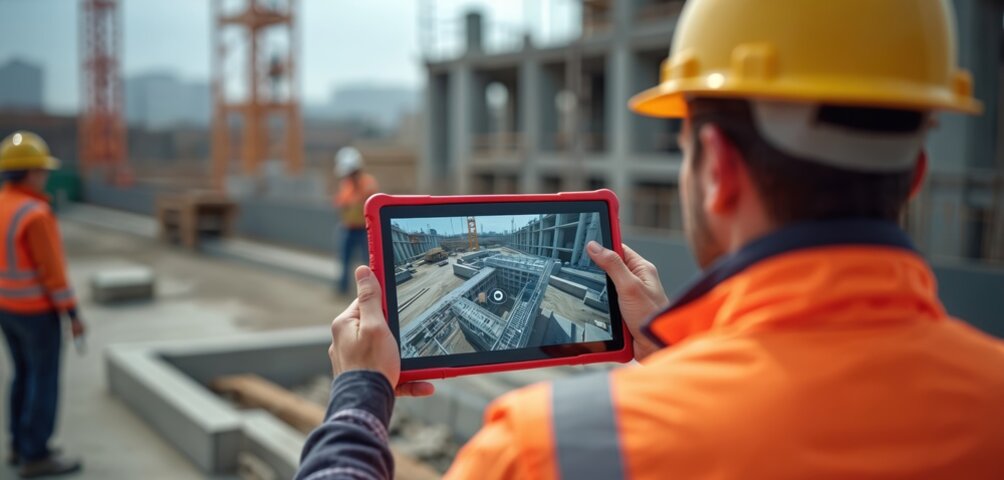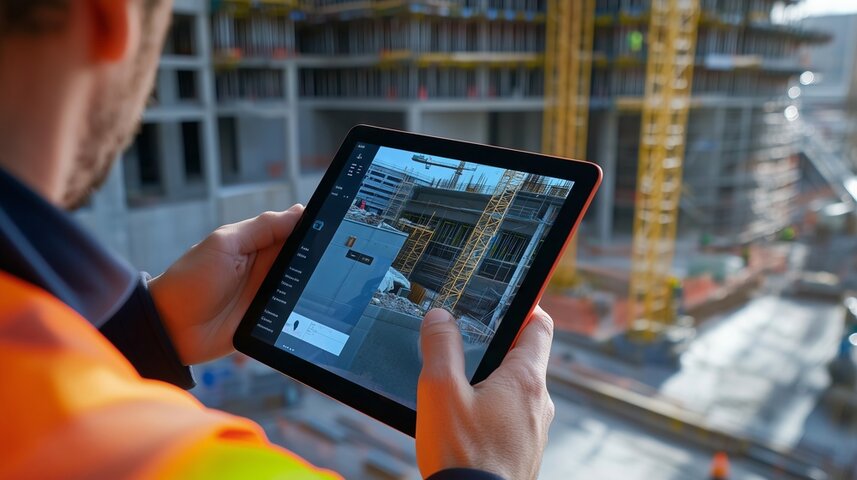The Human Side of BIM2Field: 7 Hidden Challenges Impacting Digital Construction Success
Introduction: The Worker at the Center of Digital Transformation
The construction industry is undergoing accelerated digital transformation, with the BIM2Field (Building Information Modeling to Field) methodology emerging as a crucial link between digital models and on-site operations. Although the technological benefits of BIM2Field are clear – as we previously covered in our blog post “ BIM2Field: Bridge Between the Model and Site | NS Drafter” – its implementation reveals complex psychological, organizational, and professional challenges.

This article explores the cognitive and emotional implications of introducing BIM2Field technology to both labor and engineering personnel, with particular focus on phenomena like technostress, competence-related anxiety, and professional identity dissonance.
What BIM2Field Is and How It Transforms Traditional On-Site Work into Digital Construction
Digital transformation in construction traditionally lagged behind other industries, partly due to the specific dynamics of field work and deeply rooted operational habits. The adoption of the BIM2Field approach is a turning point – it connects the digital model directly with the construction site, changing not only how work is done, but also roles, communication, and responsibility among all on-site stakeholders.

This transformation requires not only technological readiness but also a deeper understanding of the psychological impacts it has on employees – especially experienced tradespeople and engineers whose expertise was developed in an analog environment. This work calls out that human aspect of digital transformation, shedding light on psychological mechanisms of resistance, adaptation, and professional reintegration.
Role of Digital Tools in the BIM2Field Environment
Key tools include:
- Mobile devices and tablets
- Cloud platforms
- AR/VR technologies
- GNSS systems and automated total stations
These tools provide direct insight into project data, increase precision, and speed up processes – but they also bring new cognitive challenges, especially for older workers. For example, Viega reports that BIM integration saves time and costs by reducing errors and accelerating project approvals “ Digital Construction with BIM | viega.com” .
Psychological Challenges in Implementing BIM2Field Technology
Implementing BIM2Field doesn’t just bring technical changes, it opens the door to a full spectrum of psychological challenges. Research and practice identify seven key challenges faced by workers and engineers during digital transition:
Technostres
Mental strain from constant adaptation to new tech, especially when rapid adoption is expected without proper prep. Workers often feel overwhelmed as platforms demand continual attention, understanding, and updates. Without proper support and clarity, technostress can lead to burnout, loss of motivation, and withdrawal from work.
Competence Anxiety
This arises from the belief of not having the necessary skills to operate in a digital environment. Workers, especially those with long experience using analog methods feel uncertain when facing unfamiliar technologies. Such anxiety can paralyze initiative, hinder learning, and negatively impact team productivity.
Loss of Professional Identity
Digital transition often is perceived as negating previous skills and knowledge, causing a sense of personal and professional inadequacy. Workers with decades of practical know-how view digitalization as a symbolic loss of status and competence. If their role isn’t redefined inclusively, deep resistance and internal identity conflict may emerge.
Digital Polarization
This occurs when a division arises between “digitally literate” and “digital outsiders,” creating a knowledge hierarchy within teams. This division hampers collaboration, damages mutual trust, and fosters tension or ridicule. Without an active, inclusive knowledge-sharing strategy, the divide widens and threatens team cohesion.
Undermined Team Dynamics
When team members don’t “speak the same digital language,” collaboration becomes fragmented and information flow slows. Workers unfamiliar with new tools often get excluded from key decisions, leading to tension and isolation. In a healthy work environment, team dynamics should foster support and shared learning, not competition or dominance.
Passive Role in Digital Change
When management unilaterally introduces technology without involving workers in decision-making, it creates feelings of alienation and powerlessness. Workers become passive executors rather than active change participants, greatly reducing motivation and commitment. Involving employees in testing, adapting, and evaluating tools fosters a sense of ownership and collective purpose.
Lack of Structured Support and Training
One of the biggest obstacles to successful digitization is the lack of clear, tailored, and ongoing training. Without systematic support through practical workshops, mentorship, or digital guides – employees remain confused and stressed. Training must be modular, interactive, and accessible to all worker profiles, enabling step-by-step, confident learning.
Key Solutions to Humanize the Digital Transition
The digital transition must be guided by inclusive and psychologically sensitive strategies that enable complete integration – not just of systems, but the people who use them. Core components of this approach include:
Modular Training
An essential condition for successful BIM2Field integration is designing educational programs that accommodate the target group’s diversity. The workforce on-site includes various generations, educational backgrounds, digital literacy levels, and learning styles. Therefore, training should be broken into thematic modules that enable gradual knowledge acquisition, combining practical examples and real-life site simulations for immediate applicability.
Peer Mentorship
One of the most effective ways to overcome psychological resistance to digitalization is to implement peer mentorship. Experienced workers and engineers who already use BIM2Field tools serve as mentors to colleagues new to the digital environment.
Affective Validation of Traditional Knowledge
A common psychological barrier during digital transition is the loss of professional identity among employees who built their careers on traditional methods. Introducing new tools and procedures often implicitly signals that past knowledge is obsolete, which can spark resistance, frustration, and marginalization. To avoid this, it is critical to institutionally acknowledge and emotionally validate existing competencies – actively involving experienced staff in training, consultation, and evaluation of new procedures.
Feedback Mechanisms
The digital transition must not be a top-down process, it should be two-way and participatory. Establishing ongoing feedback channels enables employees to voice their suggestions, concerns, and practical insights which often escape management. These can include anonymous surveys, regular focus groups, open forums, and digital suggestion platforms. When employees see their input integrated into later versions of procedures or tools, it builds collective ownership of the transformation process, directly boosting motivation, engagement, and productivity.
Case Study: Skanska, Sweden
During the construction of a hospital in Gothenburg, Skanska implemented AR glasses and BIM2Field systems “ Skanska expands hospital in Gothenburg, Sweden, for about SEK 550M ” . Initial resistance – especially among older employees was addressed through carefully designed on-site training and a peer mentorship system. Interactive workshops and daily support transformed early skepticism into engagement. Workers gradually recognized the advantages of the technology: more efficient execution, fewer errors, and better communication with engineering teams. The key to success was gradual, humane change implementation that respects employee dignity while empowering them.
New Engineering Roles in Digital Construction
Engineers are no longer just planners – they are coordinators, analysts, and real-time decision-makers. New competencies include emotional intelligence, teamwork ability, and change leadership. Digital literacy becomes as essential as technical know-how.

Establishing digital academies, continuous training programs, and transparent communication channels is vital for preserving organizational knowledge amid rapid change. An empathetic approach that values workers’ expertise, experience, and emotional needs paves the way for truly sustainable and efficient technological evolution.
Conclusion: People as Pillars of Digital Construction
Ultimately, BIM2Field is not just a new work method, it’s a new anthropology of the construction site. It involves redefining worker and engineer identities, transforming their communication, and redistributing responsibility, knowledge, and power. Success in implementation depends not only on software and technical infrastructure, but also on the social intelligence of management, and the willingness to learn, err, adapt and collaborate. The construction industry stands at the crossroads of hammer and chip. BIM2Field is the bridge that unites them functionally. But that bridge is not built by machines; it’s built by people, and so understanding their needs, fears, and potential is critical to its stability.
Frequently Asked Questions (FAQ)
- What is BIM2Field?
It’s a method that connects the digital BIM model with on-site activities using real-time digital tools. - How does BIM2Field affect workers?
It changes their tasks, requires digital skills, and can cause psychological stress if they are not adequately trained. - What psychological challenges does digital construction bring?
Technostress, loss of identity, uncertainty in skills, and disrupted team dynamics. - How can psychological resistance to digitalization be reduced?
Through modular training, mentorship, validation of experience, and open employee communication. - How can small construction companies implement BIM2Field with minimal cost?
They can start with simple BIM2Field tools via mobile apps and cloud platforms without costly equipment. Focus on training core staff gradually, project by project. There are free or low-cost software options that support basic BIM2Field functionality.


